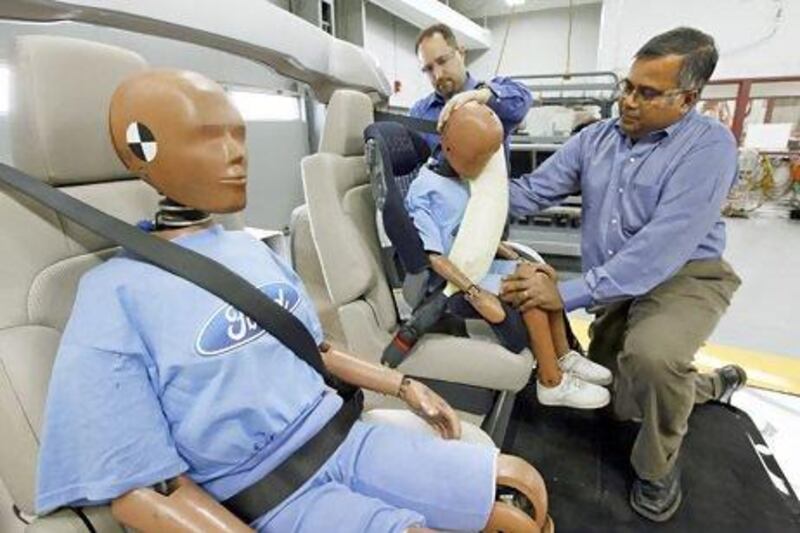Cars that fly, drive themselves and respond to your every voice command. If you'd asked someone in 1974 what we would be driving today, their answer would likely have been a combination of these seemingly science-fiction concepts.
Back then, just three years after Intel launched the first commercially available microprocessor, semiconductors began their wide-scale integration into nearly all automobiles sold. Initially used to help manufacturers meet stringent emissions guidelines, this technology has come to play a fundamental role in the modern auto industry.
"Most cars today have about 1,000 semiconductors managing everything from how your engine fires to emissions to the amount of fuel being sent to the pistons," says Jeff Darrow, the automotive segment marketing director at GlobalFoundries. "But perhaps the most important impact of this technology is on safety. Put simply, your car is always analysing and preparing for the worst scenario to ensure you come out OK - that takes a lot of intelligence and a lot of semiconductors."
According to Mr Darrow almost every car sold today is covered in a variety of sensors, constantly monitoring your acceleration vector to detect an accident before it occurs. It takes this information and communicates in real time with your brakes, seats, seat belts and airbags, which all to help manage crisis scenarios effectively in just fractions of a second.
"The airbag caused a number of injuries when first introduced because there was no intelligence behind its deployment," says Mr Darrow. "Today's airbags need to know how much the passenger weighs and where the passenger is located before deploying, even coordinating with your seat belt."
There was a 28 per cent drop in road mortalities per capita in the US between 2001 and 2010, according to the country's department of transportation.
In the same time period there was only a 14 per cent rise in seatbelt use, indicating that the incorporation of increasingly advanced technologies has played a real role in improving road safety.
While this nearly artificial intelligence is available in most cars on the market today, more forward-looking brands are utilising innovative ideas to drive safety further.
"Ford has made safety a priority and has invested in many passive and active safety features. But one of the standouts is our unique, award-winning inflatable rear seat belts," says Paul Anderson, the marketing director of Ford Middle East. "They reduce the pressure on the occupant by increasing the surface area of the belt, and provide a cushioning effect on vital areas of the body."
In what is broadly recognised as a first step towards self-driving cars, autonomous systems are also already playing a role in improving road safety.
"Many cars now use radar to look down the road at varying obstacles and see what could be in the way. They are looking within braking distance and backing it up with an intelligent camera system able to differentiate between a bag and a rock. That's a simply phenomenal level of intelligence - and it's out there today," says Mr Darrow.
"The next step is the ability for the car to start actively braking if you're getting too close to an object or car in front of you," he adds. "From a technology perspective, we're there and many cars now feature variants of this system. The main hindrance to broader implementation now lies in regulation - the legalities and ethical questions behind a car acting on its own."
The current relationship between the automotive and technology industries does not just materialise in vehicle operations, the car is becoming a fundamental element in the consumer's increasingly digital life.
"The relationship between Ford and technology has become a synergy," says Mr Anderson. "Sync and MyFord Touch, which were developed with Microsoft, bring the idea of a car as a mobile communication platform to fruition. This mating of automotive and computer technology is indicative of the way technology is influencing people's lives, so it made sense to extend the interaction with personal devices to the car."
Ford is not the only company to make this connection. Such connectivity has become nearly ubiquitous in luxury brands and is gaining increasing prevalence among mid-range ones. General Motors and VW brands, Honda and Hyundai are also staking integration with technology as a core element of the vehicle experience.
Summarising the range of offerings on the market, Mr Darrow believes access to information is only going to become more significant, "until you're essentially driving a smartphone". Many manufacturers are moving towards integrated Wi-Fi so not only does the car have information, but everyone inside the car has access to information seamlessly.
While an individual looking forward from 1974 may be disappointed at the lack of flying cars, elements of self-driving cars are becoming an increasing reality as voice commands are here in ways more complex and integrated than most could have imagined. But as nice as all this technology is, there are arguably none more impactful than those involved in safety.
As Mr. Darrow says about himself: "As much as I like Bluetooth, I like surviving accidents even more. There is no doubt the active safety features of today's cars have played a real role in saving my life, and that's definitely the most useful to me".





